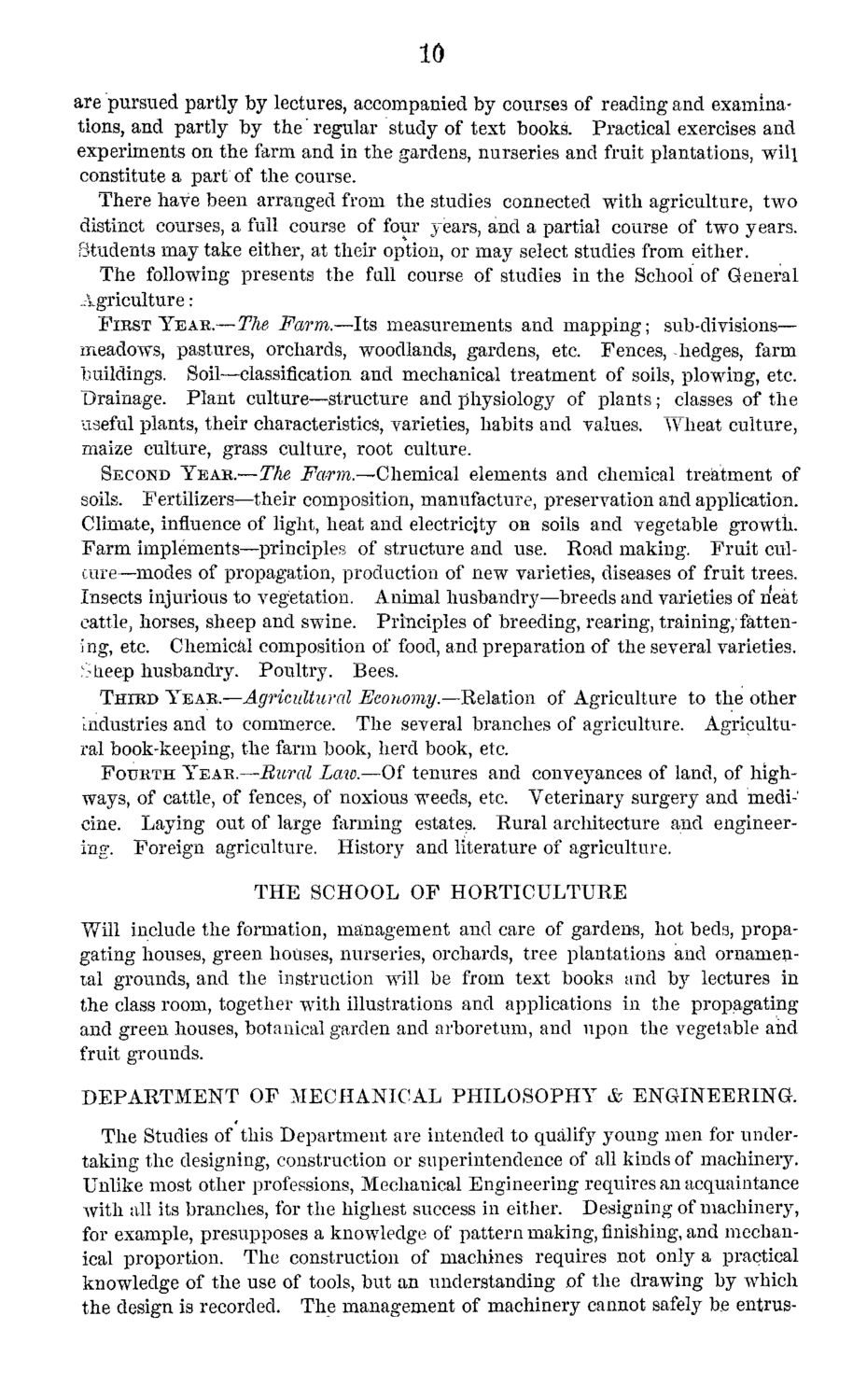| |
| |
Caption: Course Catalog - 1869-1870
This is a reduced-resolution page image for fast online browsing.

EXTRACTED TEXT FROM PAGE:
id are pursued partly by lectures, accompanied by courses of reading and examinations, and partly by the regular study of text books. Practical exercises and experiments on the farm and in the gardens, nurseries and fruit plantations, will constitute a part of the course. There have been arranged from the studies connected with agriculture, two distinct courses, a full course of four years, and a partial course of two years. Students may take either, at their option, or may select studies from either. The following presents the full course of studies in the School of General Agriculture: FIRST YEAK.—The Farm.—Its measurements and mapping; sub-divisions— meadows, pastures, orchards, woodlands, gardens, etc. Fences, hedges, farm buildings. Soil—classification and mechanical treatment of soils, plowing, etc. Drainage. Plant culture—structure and physiology of plants; classes of the useful plants, their characteristics, varieties, habits and values. Wheat culture, maize culture, grass culture, root culture. SECOND YEAH.-—The Fcvrm.—Chemical elements and chemical treatment of soils. Fertilizers—their composition, manufacture, preservation and application. Climate, influence of light, heat and electricity on soils and vegetable growth. Farm implements—principles of structure and use. Road making. Fruit cnlcure—modes of propagation, production of new varieties, diseases of fruit trees. Insects injurious to vegetation. Animal husbandry—breeds and varieties of neat cattle, horses, sheep and swine. Principles of breeding, rearing, training, fattening, etc. Chemical composition of food, and preparation of the several varieties. Slieep husbandry. Poultry. Bees. THIED YEAB.—Agricultural Economy.—Relation of Agriculture to the other industries and to commerce. The several branches of agriculture. Agricultural book-keeping, the farm book, herd book, etc. FOTJKTH YEAE.—Rural Law.—Of tenures and conveyances of land, of highways, of cattle, of fences, of noxious weeds, etc. Veterinary surgery and medicine. Laying out of large farming estates. Rural architecture and engineering. Foreign agriculture. History and literature of agriculture. THE SCHOOL OF HORTICULTURE Will include the formation, management and care of gardens, hot beds, propagating houses, green houses, nurseries, orchards, tree plantations and ornamental grounds, and the instruction will be from text books and by lectures in the class room, together with illustrations and applications in the propagating and green houses, botanical garden and arboretum, and upon the vegetable and fruit grounds. DEPARTMENT OF MECHANICAL PHILOSOPHY & ENGINEERING. The Studies of this Department are intended to qualify young men for undertaking the designing, construction or superintendence of all kinds of machinery. Unlike most other professions, Mechanical Engineering requires an acquaintance with all its branches, for the highest success in either. Designing of machinery, for example, presupposes a knowledge of pattern making, finishing, and mechanical proportion. The construction of machines requires not only a practical knowledge of the use of tools, but an understanding of the drawing by which the design is recorded. The management of machinery cannot safely be entrus-
| |